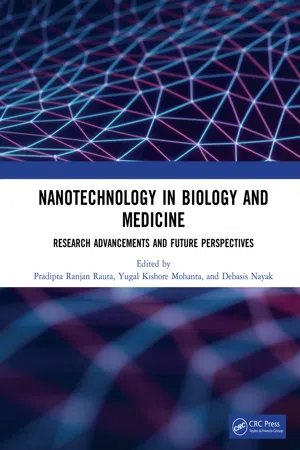
Nanotechnology in Biology and Medicine
Research Advancements & Future Perspectives
- 273 pages
- English
- ePUB (mobile friendly)
- Available on iOS & Android
Nanotechnology in Biology and Medicine
Research Advancements & Future Perspectives
About this book
Nanotechnology in biology and medicine: Research advancements & future perspectives is focused to provide an interdisciplinary, integrative overview on the developments made in nanotechnology till date along with the ongoing trends and the future prospects. It presents the basics, fundamental results/current applications and latest achievements on nanobiotechnological researches worldwide scientific era. One of the major goals of this book is to highlight the multifaceted issues on or surrounding of nanotechnology on the basis of case studies, academic and theoretical articles, technology transfer (patents and copyrights), innovation, economics and policy management.
Moreover, a large variety of nanobio-analytical methods are presented as a core asset to the early career researchers. This book has been designed for scientists, academician, students and entrepreneurs engaged in nanotechnology research and development. Nonetheless, it should be of interest to a variety of scientific disciplines including agriculture, medicine, drug and food material sciences and consumer products.
Features
- It provides a thoroughly comprehensive overview of all major aspects of nanobiotechnology, considering the technology, applications, and socio-economic context
- It integrates physics, biology, and chemistry of nanosystems
- It reflects the state-of-the-art in nanotechnological research (biomedical, food, agriculture)
- It presents the application of nanotechnology in biomedical field including diagnostics and therapeutics (drug discovery, screening and delivery)
- It also discusses research involving gene therapy, cancer nanotheranostics, nano sensors, lab-on-a-chip techniques, etc.
- It provides the information about health risks of nanotechnology and potential remedies.
- It offers a timely forum for peer-reviewed research with extensive references within each chapter
Frequently asked questions
- Essential is ideal for learners and professionals who enjoy exploring a wide range of subjects. Access the Essential Library with 800,000+ trusted titles and best-sellers across business, personal growth, and the humanities. Includes unlimited reading time and Standard Read Aloud voice.
- Complete: Perfect for advanced learners and researchers needing full, unrestricted access. Unlock 1.4M+ books across hundreds of subjects, including academic and specialized titles. The Complete Plan also includes advanced features like Premium Read Aloud and Research Assistant.
Please note we cannot support devices running on iOS 13 and Android 7 or earlier. Learn more about using the app.
Information
Section 1
Nanoscale Materials: Design, Manufacture, and Physicochemical Properties
1 Polymeric Nanostructures
CONTENTS
1.1 Introduction
Table of contents
- Cover
- Half-Title
- Title
- Copyright
- Contents
- Preface
- Acknowledgments
- Editors
- Contributors
- SECTION 1 Nanoscale Materials: Design, Manufacture, and Physicochemical Properties
- SECTION 2 Nano Biotechnology Applications on Food and Agriculture
- SECTION 3 Nano Biotechnology in Health Care/Therapeutic Applications
- SECTION 4 Biosensors/Nanochip/Nanodevice/Nanocomputing
- SECTION 5 Nanobiotecnology: Health Safety Toxicity and Environmental Impact
- Index